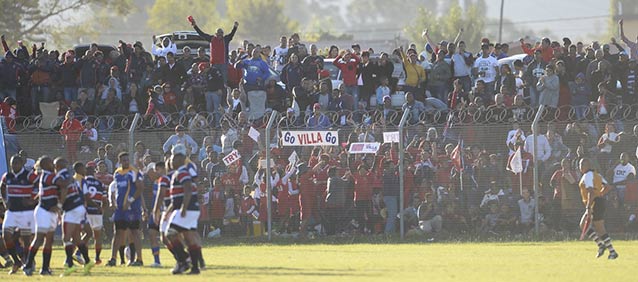
The sizeable crowds that have been turning out at club rugby matches around the country are proof of its increasing popularity.
The sizeable crowds that have been turning out at club rugby matches around the country are proof of its increasing popularity.
Boland champions and Gold Cup qualifiers Onelogix United Bulk Worcester Villagers had to dig deep to beat neighbours and arch-rivals Young Hamiltons 26-20 last weekend in a match played in front of one of the largest recorded crowds to ever watch a club league match in South Africa.
The 11,347 fans who packed Esselen Park in Worcester for the much-anticipated showdown were treated to a thrilling encounter between two clubs with a combined age of 201 years – Villagers having been founded in 1883 and Hammies in 1948.
The match comes just a fortnight after Alberton Rugby Club in Gauteng drew a crowd of 16,784 for a provincial-club double header, with the Xerox Golden Lions playing the Vodacom Blue Bulls in a curtain-raiser to a Pirates Grand Challenge league match between Alberton and Union.
“It’s very clear looking at these massive crowd figures that club rugby is thriving around the country,” said SARU CEO Jurie Roux.
“People are beginning to flock back to clubs to watch their local heroes in action and in turn the standard of club rugby has increased exponentially. Some of our amateur clubs are attracting bigger crowds than many professional clubs in some of the world’s most famous leagues, and that is something we are very proud of.
“Club rugby unites communities and Saturday’s match in Worcester showed just how relevant club rugby is, not only from a rugby viewpoint but also as a vehicle for transformation and social cohesion, especially on the platteland.”
Roux added that the recent performances of former Boland schoolboy Garth April for the Cell C Sharks in Vodacom Super Rugby was proof that club rugby could still produce professional players.
“A year ago, Garth was kicking the winning points for Durbanville-Bellville in the Gold Cup and now he is doing likewise – and scoring his trademark tries – against some of the best players in the world,” said Roux.
“The revival of club rugby remains very much a work-in-progress but through the Gold Cup and other initiatives we will continue to provide aspirational platforms so that the next Garth April can emerge. On this note we hope to make further exciting announcements around club rugby in the very near future.”
The Gold Cup will kick off on Saturday, 10 September, with the 20 clubs once again competing in a Rugby World Cup-style format, with five weeks of pool stages up until 8 October and the top two from each group progressing to the quarterfinals a week later. All knockout matches, including the semifinals (22 October) and grand final (29 October) will be hosted at participating clubs.
Sixteen clubs are already confirmed for the season-ending tournament, including current Namibian Premier League log-leaders FNB Wanderers Windhoek. Zimbabwe’s qualifier will be decided next month, with Harare-based Old Georgians, Harare Sports Club and Old Hararians among the early favourites.
The race for the remaining two qualifier slots will be contested by those clubs who finish the 2016 league season as the top non-university club in their province, having not done so in 2015. The qualifiers will be played on 20 and 27 August, with the Gold Cup kicking off a fortnight later with a televised opening match.